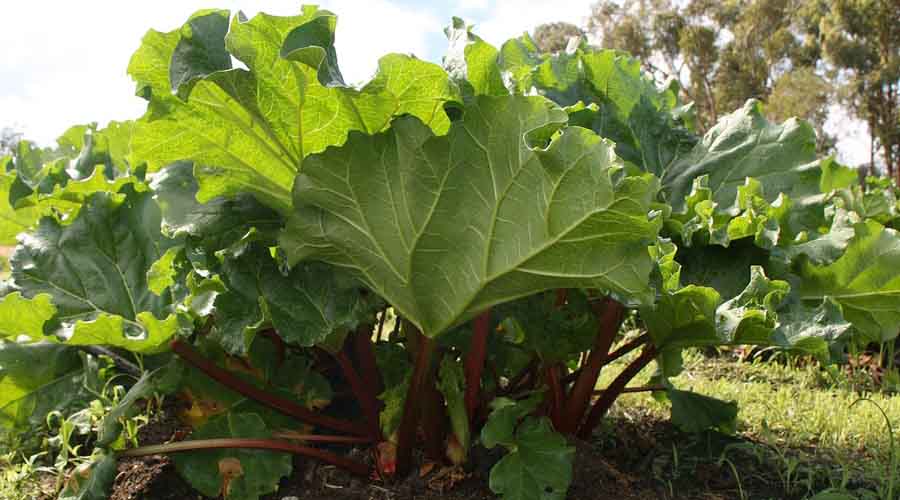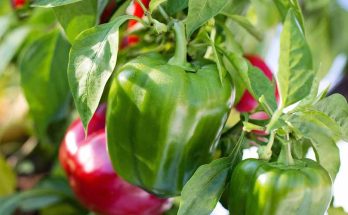Rhubarb companion plants. This is the main topic of today’s post. Rhubarb is a perennial vegetable meaning it lives in one place for many years. Rhubarb is basically a cold hardy vegetable that you can eat as a fruit as well. Those interested in growing rhubarb will hopefully benefit from reading this post. It should be remembered that companion planting is very important for all crops. There are two sides to companion planting, one good and one bad, so before planting rhubarb companion plants in your garden, you need to know about good and bad companions. In this post, we will discuss some good and some bad companions for rhubarb so read the whole post carefully for details.
Contents
Rhubarb Companion Plants
Rhubarb, with its bold, courtesan stalks and vibrant green leaves, is a cherished addition to numerous auditoriums and kitchens. This hardy imperishable factory isn’t only famed for its culinary uses but also for its seductive presence in the garden geography. Yet, to ensure the health and vitality of your rhubarb patch, it’s essential to consider the concept of companion planting. Companion plants play a pivotal part in enhancing the growth and productivity of rhubarb while furnishing a harmonious and balanced ecosystem in your garden. In this disquisition of rhubarb companion plants, we will claw into the art of factory pairing, unveiling the secret abettors that can help your rhubarb thrive, and the benefits of these symbiotic connections. Whether you are a seasoned gardener or just beginning your horticultural trip, understanding the community between rhubarb and its companions can lead to a more fruitful and harmonious garden.
Good Companion Plants For Rhubarb
Gardening is an art, a delicate cotillion between soil, sun, and seasons. For those who cherish the bold, pungent stalks of rhubarb, there is a secret to making this imperishable factory truly flourish in the art of companion planting.
Cantaloupe Companion Plants | 31 Good And Bad Companion Plants For Cantaloupe
By opting for the right neighbors for your rhubarb, you can enhance its growth, cover it from pests, and produce a thriving, balanced garden. In this comprehensive companion, we’ll explore 21 inconceivable rhubarb companion plants, each with its unique part in transforming your garden into a flourishing ecosystem.
Strawberries
The Sweet and Sour Duo Rhubarb and strawberries are a classic garden pairing. Strawberries give ground cover and reduce weed competition, while both combine wonderfully in culinary creations.
Garlic
Repelling Pests with Aroma Garlic’s pungent scent acts as a natural pest interference, securing your rhubarb from unwanted callers.
Onions
Minimum Space, Maximum Benefits Onions take up little space and help discourage pests, contributing to a healthy garden ecosystem.
Beans
Nitrogen- Fixing Abettor beans enriches the soil by fixing nitrogen, icing your rhubarb to receive the nutrients it needs to thrive.
Lettuce – Rhubarb Companion Plants

Shade and humidity Conservation Lettuce provides shade and humidity conservation for rhubarb, reducing the need for frequent watering and weeding.
Horseradish
Natural Pest Repellent Horseradish’s strong aroma repels a variety of pests, icing your rhubarb stays pest-free.
Nasturtiums
Attracting Salutary Insects Nasturtiums can bait salutary insects into your garden while abstracting and repelling pests.
Chives
Aphid interference Chives help discourage aphids from your rhubarb, contributing to their overall health.
Rhubarb Companion Plants Tansy
Aroma That Repels Pests Tansy’s scent keeps multitudinous garden pests at bay, creating a healthier terrain for your rhubarb.
Borage
Bringing in Pollinators Borage attracts pollinators, improves soil health, and acts as a dynamic companion for rhubarb.
Mint
Repelling Pests and furnishing Ground Cover Mint helps repel pests and offers ground cover, keeping the soil cool and weed-free.
Marigolds
Nematode interference Marigolds discourage nematodes and numerous other pests that could harm your rhubarb.
Dill – Rhubarb Companion Plants
Attracting salutary Insects Dill is an attraction for salutary insects like ladybugs and parasitic wasps, securing your rhubarb from destructive pests.
Oregano
A scrumptious Companion Oregano acts as a natural pest repellent while enhancing your culinary trials.
Bee Balm
Attracting Pollinators Bee attar draws pollinators to your garden, icing that your rhubarb receives the necessary attention for successful fruiting.
Lavender
Scent and Pest Control Lavender’s ambrosial aroma repels pests and adds a touch of beauty to your garden.
Rhubarb Companion Plants Comfrey
Mulching for Soil Enrichment Comfrey leaves make excellent mulch, contributing to soil health and fertility around your rhubarb.
Yarrow
salutary Insects and Soil Enhancement Yarrow attracts salutary insects and aids in soil enhancement, icing a thriving garden.
Rhubarb Leaf Mulch
The Rhubarb- Exclusive Mulch Using rhubarb leaves as mulch can help discourage pests and enrich the soil.
Thyme
Pest Control and Ground Cover Thyme can discourage pests and give ground cover, further serving your rhubarb.
Catnip
Aphid Control Catnip helps control aphids, guarding your rhubarb from their implicit damage.
Rhubarb Companion Plants Chart
The rhubarb companion plants chart is given below tables:
| Serial | Companion Plants | Benefits |
| 1 | Strawberries: | Rhubarb and strawberries complement each other both in the garden and on the plate. |
| 2 | Garlic: | The strong scent of garlic can deter pests that might harm rhubarb. |
| 3 | Onions: | Onions can help repel pests while taking up minimal space in the garden. |
| 4 | Beans: | Beans fix nitrogen in the soil, which can benefit rhubarb’s growth. |
| 5 | Lettuce: | Lettuce provides shade and helps conserve soil moisture for rhubarb. |
| 6 | Horseradish: | Horseradish can act as a natural pest repellent for rhubarb. |
| 7 | Nasturtiums: | These flowers can attract beneficial insects and distract pests. |
| 8 | Chives: | Chives can help deter aphids and protect rhubarb. |
| 9 | Tansy: | Tansy’s aroma repels many garden pests. |
| 10 | Borage: | Borage attracts pollinators and improves soil health. |
| 11 | Mint: | Mint can help repel pests and provide ground cover. |
| 12 | Marigolds: | Marigolds can deter nematodes and other pests. |
| 13 | Dill: | Dill attracts beneficial insects like ladybugs and parasitic wasps. |
| 14 | Oregano: | Oregano can act as a natural pest repellent and enhance flavor in the kitchen. |
| 15 | Bee Balm: | Bee balm attracts pollinators and beneficial insects. |
| 16 | Lavender: | Lavender’s scent can deter pests and add beauty to the garden. |
| 17 | Comfrey: | Comfrey leaves can be used as a mulch to enrich the soil. |
| 18 | Yarrow: | Yarrow attracts beneficial insects and can improve soil health. |
| 19 | Rhubarb leaf mulch: | Using rhubarb leaves as mulch can help deter pests and enrich the soil. |
| 20 | Thyme: | Thyme can deter some garden pests and provide ground cover. |
| 21 | Catnip: | Catnip can help keep certain pests, like aphids, away from rhubarb. |
Bad Companion Plants For Rhubarb
While companion planting can give multitudinous benefits to your garden, it’s also important to be apprehensive of plants that may not be suitable companions for rhubarb. Some plants can contend for coffers, hamper growth, or indeed have negative goods on each other. There are many exemplifications of bad companion plants for rhubarb.
Potatoes
Rhubarb and potatoes both bear a lot of space and nutrients and planting them together can lead to increased competition for coffers, potentially reducing the yield of both crops.
Tomatoes
Tomatoes are susceptible to numerous of the same pests and conditions that affect rhubarb. Planting them together can increase the threat of these issues.
Cabbage Family( Broccoli, Cauliflower, Cabbage, etc.)
Rhubarb and cabbage family plants have different soil pH preferences. Cabbage family plants prefer alkaline soil, while rhubarb prefers slightly acidic soil. Planting them together may lead to sour growing conditions for one or both.
Beans ( especially pole beans)
While backcountry sap can be salutary companions due to nitrogen-fixing capabilities, pole sap can overshadow and contend with rhubarb for the sun.
Carrots
Carrots and rhubarb have different root depths and growth rates. Planting them together may lead to overcrowding and reduced yields for both.
Fennel
Fennel can inhibit the growth of near plants due to its allelopathic parcels, which can negatively affect the growth of rhubarb.
Sunflowers
Tall sunflowers can shade out rhubarb and other plants, reducing their access to sun and affecting growth.
Lily of the Valley
This imperishable ground cover can be invasive and outcompete rhubarb, making it a bad neighbor in the garden.
Mint
While mint can be a salutary companion in some situations, it can become invasive and catch the garden, potentially choking out rhubarb and other plants.
Rhubarb itself
Planting rhubarb too close to other rhubarb plants can lead to overcrowding, which can reduce the overall yield of the rhubarb patch.
Thyme Companion Plants | 31 Good And Bad Companion Plants For Thyme
Note that in companion planting, it’s essential to consider the specific requirements and growth habits of each factory to produce a harmonious garden. Avoiding the pairing of plants with disagreeing conditions and implicit negative relations can help ensure a successful and thriving garden.
Finally About Rhubarb Companion Plants
By embracing these 21 rhubarb companion plants, you can produce a garden that thrives not just in insulation but as a connected ecosystem. Each factory plays a unique part in enhancing the growth and well-being of your cherished rhubarb, making your garden a place of cornucopia, harmony, and beauty.
Rhubarb Companion Plants Questions (FAQ)
What should you not plant next to rhubarb?
Potatoes and rhubarb shouldn’t be planted together as they can contend for space and nutrients, hindering each other’s growth.
What grows best with rhubarb?
Rhubarb grows well with strawberries, garlic, onions, sap, lettuce, horseradish, and colorful sauces like mint, oregano, and thyme.
Can you plant rhubarb next to tomatoes?
It’s stylish to avoid planting rhubarb coming to tomatoes as they’ve different soil and care conditions. Rhubarb prefers slightly acidic soil, while tomatoes thrive in a more alkaline terrain.
What’s the best natural fertilizer for rhubarb?
Well-rotted compost or aged ordure is an excellent natural toxin for rhubarb. These organic accouterments enrich the soil and give essential nutrients.
How can I make my rhubarb grow faster?
To promote brisk rhubarb growth, ensure it receives acceptable sun, and water constantly, and apply a balanced organic toxin in the spring. also, regularly removing flower stalks can divert energy to splint and stem growth, enhancing overall factory development.





